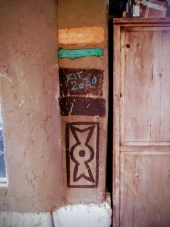I am trying to get a house built so I won't have to spend next winter in my tent. Materials must all come from on-site, aside from some bits of hardware, e.g. nails.
I'll just lay it out for you. Please let me know what you think. Any suggestions are welcome.
- - -
The house will be a cruck frame with cob walls, a very crude stone foundation, and white oak shakes for roofing, 45° pitch. The floor will be packed clay over rubble. The ceiling will be cob as well, amply supported but no thicker than necessary in case it gets wet, probably flat but I like tall N windows, so it's hard to say for sure. No plaster under the rafters - I want to be able to see the roof for inspection. It will be heated by a large mass stove.
The issue is with the walls and foundation. I had very good luck with a small block I made from sifted, undoctored subsoil from the site where I'm already planning to make a sand filter for roof runoff collection, so I'm pretty happy with that. I have no access to straw without shelling out money, but I can make long strips of wood fiber with my drawknife, so I'm going with that. Laborious, but it will work. I hope.
I have tons of stone on my property, but it is all little misshapen chunks of chert, rarely larger than 8" at its widest dimension and with no real grain to it but plenty of random fractures. The best stuff is hard and glassy, but more than half of it is deeply weathered. With this in mind, I am hoping to go for more of a mounded foundation, sloping heavily outward for stability and with a slight drainage slope in the surrounding 10', maybe 2:12 or something like that. I can't have too much or the frost heave will be really bad.
So...yeah. Very crude foundation of small, irregular stones and cob with wood fiber.
Can this last at least long enough to regenerate the timber? What do you think?
No, there will be no insulation, and concrete is not an option. I could wind up doing something pretty crazy, though, like glass for the windows, but not for a while.





